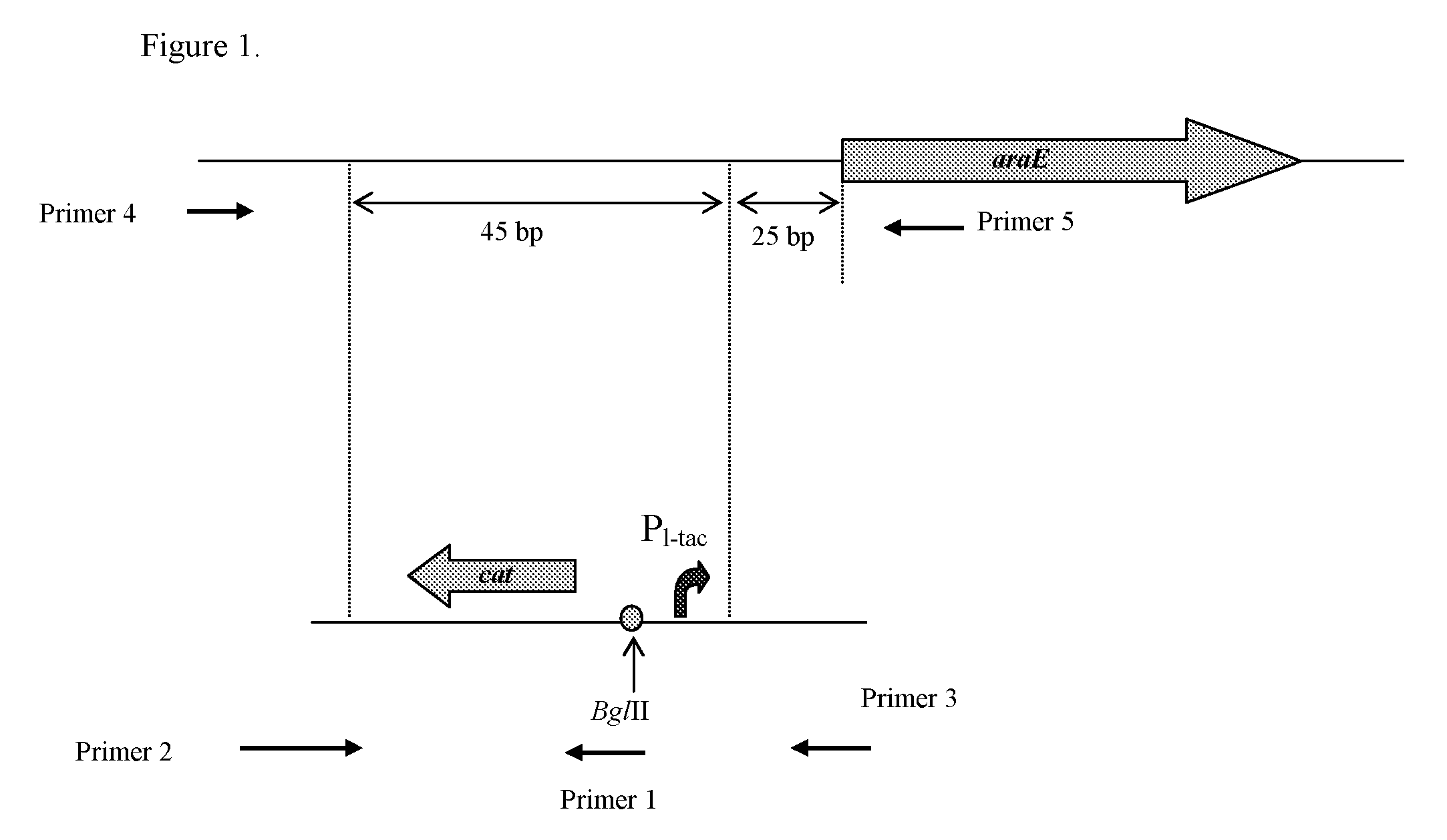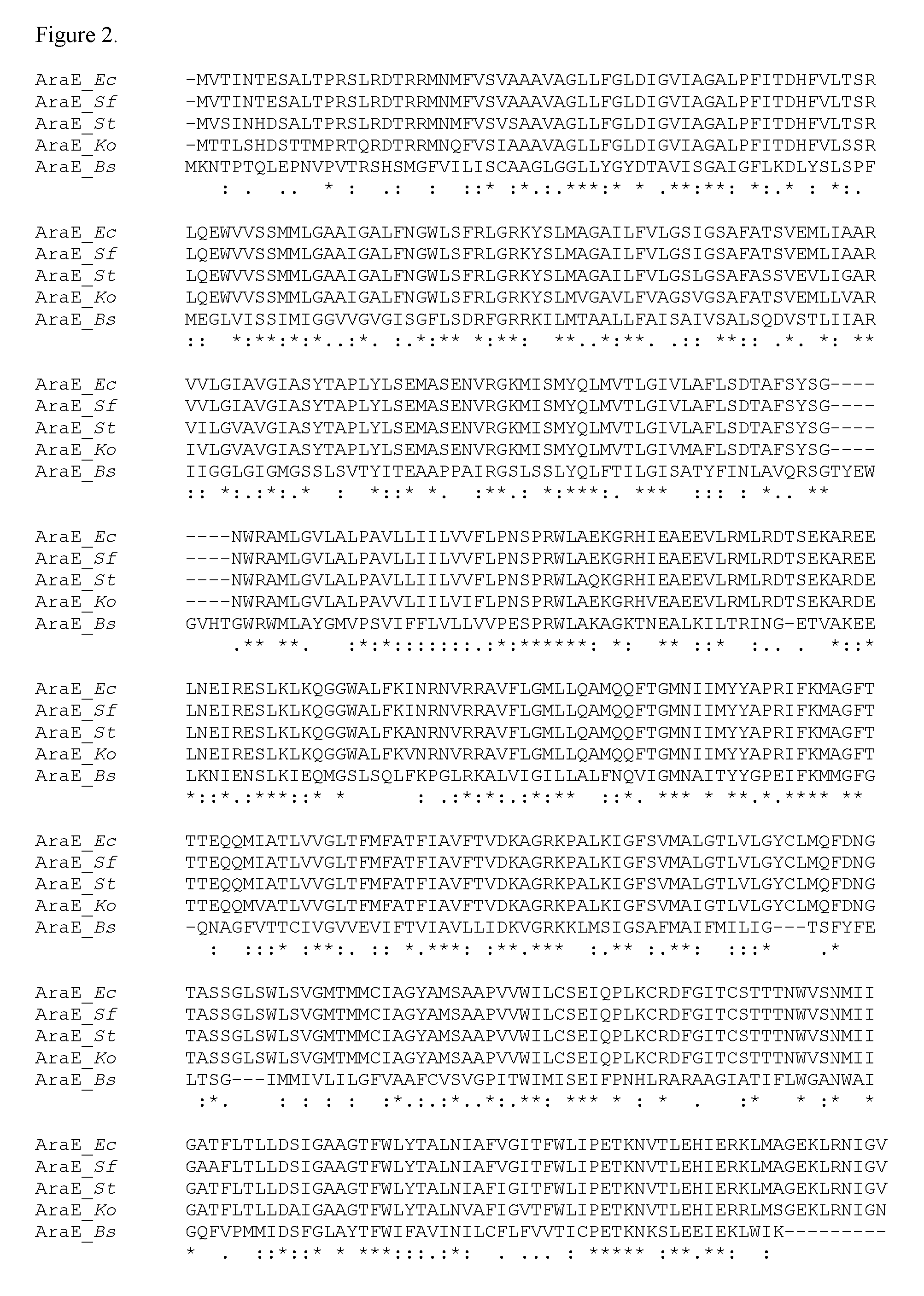Method for Producing L-Amino Acids Using Bacteria of the Enterobacteriaceae Family
- Summary
- Abstract
- Description
- Claims
- Application Information
AI Technical Summary
Benefits of technology
Problems solved by technology
Method used
Image
Examples
example 1
Substitution of the native promoter region of araE gene in E. coli by hybrid PL-tac promoter
[0139] To substitute the native promoter region of the araE gene, a DNA fragment carrying a hybrid PL-tac promoter and chloramphenicol resistance marker (CmR) encoded by the cat gene can be integrated into the chromosome of E. coli MG1655 (ATCC 700926) in place of the native promoter region by the method described by Datsenko K. A. and Wanner B. L. (Proc. Natl. Acad. Sci. USA, 2000, 97, 6640-6645), which is also called as a “Red-mediated integration” and / or “Red-driven integration”. The recombinant plasmid pKD46 (Datsenko, K. A., Wanner, B. L., Proc. Natl. Acad. Sci. USA, 2000, 97, 6640-6645) having a thermosensitive replicon can be the donor of the phage λ-derived genes responsible for the Red-mediated recombination system. Escherichia coli BW25113 containing the recombinant plasmid pKD46 can be obtained from the E. coli Genetic Stock Center, Yale University, New Haven, USA, the accession n...
example 2
Effect of Increasing the araE Gene Expression on L-Threonine Production
[0146] To test the effect of enhanced expression of the araE gene under the control Of PL-tac promoter on threonine production, DNA fragments from the chromosome of the above-described E. coli MG1655PL-tacaraE can be transferred to the threonine-producing E. coli strain VKPM B-3996 by P1 transduction (Miller, J. H. (1972) Experiments in Molecular Genetics, Cold Spring Harbor Lab. Press, Plainview, N.Y.).
[0147] Both E. coli strains B-3996 and B-3996PL-tacaraE can be grown for 18-24 hours at 37° C. on L-agar plates. To obtain a seed culture, the strain can be grown on a rotary shaker (250 rpm) at 32° C. for 18 hours in 20×200 mm test tubes containing 2 ml of L-broth with 4% sucrose. Then, the fermentation medium can be inoculated with 0.21 ml (10%) seed material. The fermentation can be performed in 2 ml of minimal medium for fermentation in 20×200 mm test tubes. Cells can be grown for 48 hours at 32° C. with sha...
example 3
Effect of Increasing the araE Gene Expression on L-Lysine Production (1)
[0151] To test the effect of enhanced expression of the araE gene under the control Of PL-tac promoter on lysine production, DNA fragments from the chromosome of the above-described E. coli MG1655PL-tacaraE can be transferred to the lysine-producing E. coli strain WC196 (pCABD2) by P1 transduction (Miller, J. H. (1972) Experiments in Molecular Genetics, Cold Spring Harbor Lab. Press, Plainview, N.Y.). pCABD2 is a plasmid comprising a dapA gene coding for a dihydrodipicolinate synthase having a mutation which desensitizes feedback inhibition by L-lysine, a lysC gene coding for aspartokinase III having a mutation which desensitizes feedback inhibition by L-lysine, a dapB gene coding for a dihydrodipicolinate reductase gene, and a ddh gene coding for diaminopimelate dehydrogenase (U.S. Pat. No. 6,040,160).
[0152] Both E coli strains WC196(pCABD2) and WC196(pCABD2)PL-tacaraE can be cultured in the L-medium containi...
PUM
| Property | Measurement | Unit |
|---|---|---|
| Temperature | aaaaa | aaaaa |
| Fraction | aaaaa | aaaaa |
| Concentration | aaaaa | aaaaa |
Abstract
Description
Claims
Application Information
 Login to View More
Login to View More - Generate Ideas
- Intellectual Property
- Life Sciences
- Materials
- Tech Scout
- Unparalleled Data Quality
- Higher Quality Content
- 60% Fewer Hallucinations
Browse by: Latest US Patents, China's latest patents, Technical Efficacy Thesaurus, Application Domain, Technology Topic, Popular Technical Reports.
© 2025 PatSnap. All rights reserved.Legal|Privacy policy|Modern Slavery Act Transparency Statement|Sitemap|About US| Contact US: help@patsnap.com


